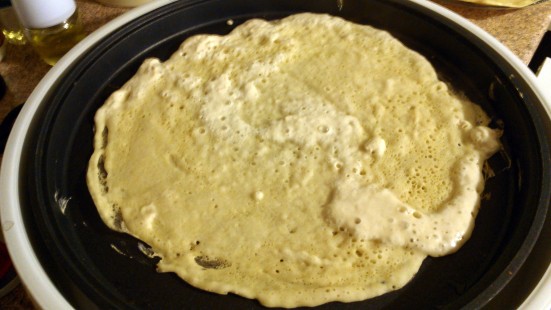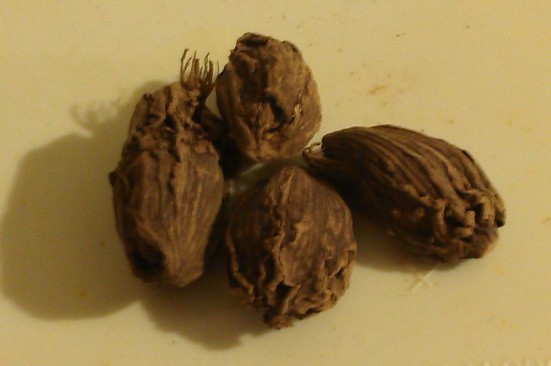In the past few weeks, I’ve approached every dish with a bit of trepidation, which is pretty unusual for me. Typically, my attitude towards cooking is whimsical; haphazardly throwing spices and ingredients together without much of a thought, putting all my faith in whatever recipe I have written down. Not so much with Africa. I’m not sure why, but lately I’ve been second guessing everything, measuring ingredients with more accuracy than normal, and questioning the sanity of every author whose recipe I try. I didn’t realize exactly HOW cautious I’ve been lately until Tomato commented on how everything I’ve served so far in Africa comes with a side of skepticism. This is completely unfounded, because I can’t say I’ve been disappointed once. Determined to overcome my mental block, I forge on today and present tonight’s dish: injera and tsebihi birsen.. So roll up your sleeves, because it’s getting messy.
Have you ever had Ethiopian food? I’ve tried it a handful (literally) of times thanks to a plethora of options here in Chi-town, and it’s fantastic. I say literally a handful because, in case you aren’t familiar with this type of cuisine, you eat with your hands. Rather than using utensils, Ethiopian food is served on and with a sort of spongy flat bread called injera. Just rip a piece off and then use that to pick up whatever you want to put in your mouth. Saves on dirty dishes for sure, but to be honest, I find injera the least appealing part of an Ethiopian meal because, in my opinion, all that bread just takes up valuable tummy space that I’d rather fill with other tasty goods. Also, I don’t particularly like eating with my hands. Even as a kid, I was a little OCD about not touching food with my hands, and even went out of my way to wrap napkins around my utensils to keep my hands clean. Don’t be scared, I outgrew the crazy long ago, but I still like to keep things tidy at mealtime. Still, in the spirit of authenticity, injera was on tonight’s menu as the scooper for some spicy red lentils, or tsebhi birsen.
I had actually intended on making this last week, but when I went to make the batter for the injera, I was shocked and dismayed to learn that the batter had to ferment for three days to give it a sourdough-y taste. Ugh. Delayed gratification on this one. Anyway, injera is usually made with teff, a grain that grows in higher elevations. An alternative to teff, and what I used here, is a combination of white, whole wheat and self-rising flours, mixed with liquid to a consistency that makes a flatbread thicker than a crepe and thinner than regular pancakes. After letting it sit on my counter doing its thing for three days, I got to work. These are typically made on a clay plate or cast iron, but I have a large electric griddle thing and I used that instead, heated to about 350 degrees. Unlike traditional pancakes or crepes, you only cook these on one side until the top is bubbled and spongy. I doubted that the second side would actually cook and stay doughy (like if you would not flip a pancake), but again I was proved wrong. Trust the recipe, trust the method, and it’ll come out.
- 3 cups white flour
- 1/3 cup whole wheat flour
- 1/3 cup self-rising flour
- 1 packet active dry yeast
- 1 tsp baking soda
- 1 tsp salt
- 1 ½ cup water (more or less, depending on consistency- remember, thicker than a crepe, thinner than a pancake)
- Mix together the flours, yeast and water. Set aside, uncovered on the counter, for about three days.
- After the dough has fermented, mix in the salt and baking soda.
- Heat a large non-stick skillet over medium heat. Pour about 1/3 cup of the batter into the pan in a spiral pattern to cover the bottom of the pan evenly. Tilt the pan to quickly even out the batter. Allow to cook for about 3 minutes. The bread will rise slightly.
- This is cooked only on one side, so the top should be slightly moist. Remove to a platter and cool. Stack the cooked breads on a plate. It’s very spongy!
Take 1. Injera should NOT look like this. The batter was too thick, so I added more water.
Much better.
Next, what good is bread without something to eat it with? NO, I take that back. Bread is always good, even when alone (I’ve mentioned it before- I LOVE bread). In this case however, the bread was meant to be a scooper, so I need something to scoop. On to the lentils!
Despite the fact that I grew up eating lentils prepared the Southeast Asian way, I rarely cook with them. I’ve probably made a total of five lentil dishes in my whole life. I have no idea what my deal is because I love lentils and they couldn’t be easier.
I had to seek out the black cardamom. I wasn’t really sure what the difference would be, but it has a more licorice-taste, is a bit stronger and smokier. Anyway, I think it’d be okay if you can’t find it- just use green
Black cardamom pods
Dig in!
Injera and Tsebhi Birsen
Injera and Tsebhi Birsen is classic Ethiopian spongy flatbread served with spiced red lentils for a balanced and satisfying meal.
Ingredients
- For the Injera
- 3 cups white flour
- 1/3 cup whole wheat flour
- 1/3 cup self-rising flour
- 1 packet active dry yeast
- 1 tsp baking soda
- 1 tsp salt
- 1 ½ cup water (more or less, depending on consistency- remember, thicker than a crepe, thinner than a pancake)
- For the Tsebhi Birsen:
- 1 1/3 cup red lentils
- 1 medium onion, finely diced
- 1 TB vegetable oil
- 2 TB Berbere spice (found in most spice stores)
- 1 cup crushed tomatoes
- 1 TB tomato paste
- 1 tsp cumin
- ½ tsp black cardamom, the insides**
- 5 cloves crushed garlic
- 4-5 cups water (enough to cover the lentils)
- Salt and pepper, to taste
Directions
- Step 1 Make the injera: Mix together the flours, yeast and water. Set aside, uncovered on the counter, for about three days.
- Step 2 After the dough has fermented, mix in the salt and baking soda.
- Step 3 Heat a large non-stick skillet over medium heat. Pour about 1/3 cup of the batter into the pan in a spiral pattern to cover the bottom of the pan evenly. Tilt the pan to quickly even out the batter. Allow to cook for about 3 minutes. The bread will rise slightly.
- Step 4 This is cooked only on one side, so the top should be slightly moist. Remove to a platter and cool. Stack the cooked breads on a plate. It’s very spongy!
- Step 5 Make the lentils: Add the oil and onion to a saucepan. Cook until soft, then add the spices. Add everything else.
- Step 6 Let simmer about 45-60 minutes until the lentils are tender. Scoop up with the injera.






